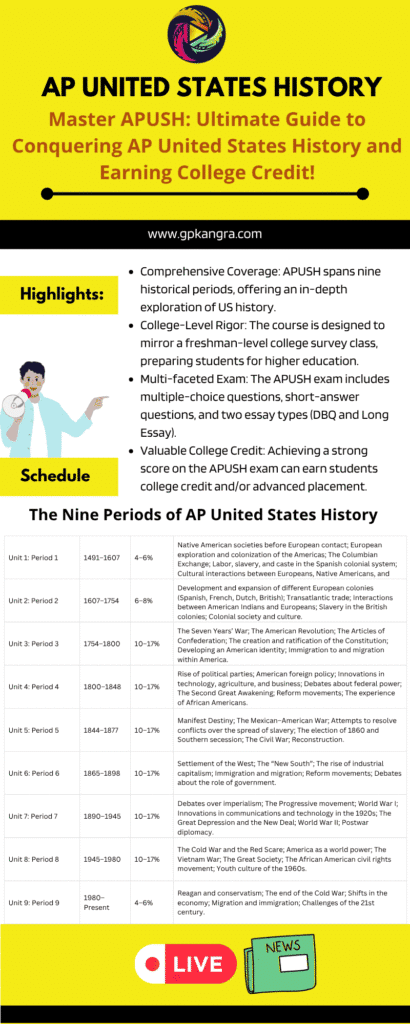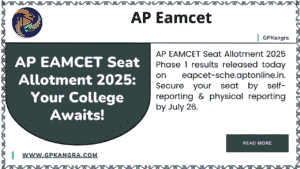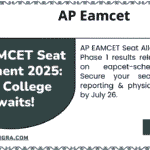This article delves into APUSH (AP United States History), a rigorous college-level course offered by College Board. It covers the comprehensive curriculum spanning from the pre-Columbian era to the present, explores the exam structure, and discusses its significance for college credit and future career paths.
Highlights:
- Comprehensive Coverage: APUSH spans nine historical periods, offering an in-depth exploration of US history.
- College-Level Rigor: The course is designed to mirror a freshman-level college survey class, preparing students for higher education.
- Multi-faceted Exam: The APUSH exam includes multiple-choice questions, short-answer questions, and two essay types (DBQ and Long Essay).
- Valuable College Credit: Achieving a strong score on the APUSH exam can earn students college credit and/or advanced placement.

Master APUSH: Your Ultimate Guide to Conquering AP United States History and Earning College Credit!
Are you a high school student with a keen interest in the intricate tapestry of American history? Do you aspire to gain a head start on your college education while still in high school? If so, then APUSH, or AP United States History, is a course you simply must explore.
This comprehensive, college-level program, offered by the esteemed College Board, is far more than just another history class; it’s an immersive journey through centuries of American development, designed to challenge and equip you with critical thinking skills vital for academic and professional success.
What Exactly is APUSH? Unpacking AP United States History
APUSH, formally known as Advanced Placement United States History, is a cornerstone of the Advanced Placement Program. It’s meticulously crafted to deliver the same depth of content and instructional rigor that students would encounter in a freshman-level college survey course.
This means you’ll be engaging with college-level textbooks, delving into primary and secondary sources, and grappling with complex historical concepts from the get-go. The ultimate goal? To provide you with a profound understanding of how the United States came to be, how it evolved, and the forces that continue to shape it.
The course curriculum is thoughtfully divided into nine distinct periods, each representing a crucial epoch in American history. These periods span from the pre-Columbian era, before European contact with Native Americans, all the way to the present day. This broad sweep ensures a holistic understanding of the nation’s journey, from its foundational moments to its contemporary challenges.

The Nine Periods of AP United States History
To give you a clearer picture, here’s a breakdown of the historical periods covered in AP United States History, along with their approximate weighting on the exam:
| Unit 1: Period 1 | 1491–1607 | 4–6% | Native American societies before European contact; European exploration and colonization of the Americas; The Columbian Exchange; Labor, slavery, and caste in the Spanish colonial system; Cultural interactions between Europeans, Native Americans, and Africans. |
| Unit 2: Period 2 | 1607–1754 | 6–8% | Development and expansion of different European colonies (Spanish, French, Dutch, British); Transatlantic trade; Interactions between American Indians and Europeans; Slavery in the British colonies; Colonial society and culture. |
| Unit 3: Period 3 | 1754–1800 | 10–17% | The Seven Years’ War; The American Revolution; The Articles of Confederation; The creation and ratification of the Constitution; Developing an American identity; Immigration to and migration within America. |
| Unit 4: Period 4 | 1800–1848 | 10–17% | Rise of political parties; American foreign policy; Innovations in technology, agriculture, and business; Debates about federal power; The Second Great Awakening; Reform movements; The experience of African Americans. |
| Unit 5: Period 5 | 1844–1877 | 10–17% | Manifest Destiny; The Mexican–American War; Attempts to resolve conflicts over the spread of slavery; The election of 1860 and Southern secession; The Civil War; Reconstruction. |
| Unit 6: Period 6 | 1865–1898 | 10–17% | Settlement of the West; The “New South”; The rise of industrial capitalism; Immigration and migration; Reform movements; Debates about the role of government. |
| Unit 7: Period 7 | 1890–1945 | 10–17% | Debates over imperialism; The Progressive movement; World War I; Innovations in communications and technology in the 1920s; The Great Depression and the New Deal; World War II; Postwar diplomacy. |
| Unit 8: Period 8 | 1945–1980 | 10–17% | The Cold War and the Red Scare; America as a world power; The Vietnam War; The Great Society; The African American civil rights movement; Youth culture of the 1960s. |
| Unit 9: Period 9 | 1980–Present | 4–6% | Reagan and conservatism; The end of the Cold War; Shifts in the economy; Migration and immigration; Challenges of the 21st century. |
To succeed in APUSH, you’ll likely be using a college-level textbook. Some commonly used texts that meet the curriculum requirements include:
- America’s History (Henretta et al.)
- American History: A Survey (Brinkley)
- American Passages (Ayers et al.)
- The American Pageant (Bailey et al.)
- The American People (Nash et al.)
- By the People (Fraser)
- The Enduring Vision (Boyer et al.)
- Give Me Liberty! (Foner)
- Liberty, Equality, Power (Murrin et al.)
- Out of Many (Faragher et al.)
- A People and a Nation (Norton et al.)
- Fabric of a Nation (Stacy et al.)
These textbooks serve as your foundation, providing the factual knowledge and analytical frameworks necessary to understand the complexities of AP United States History.
Developing Essential Skills in APUSH
Beyond rote memorization of dates and names, APUSH emphasizes the development of crucial historical thinking skills. These are not only invaluable for excelling on the exam but also for navigating information and forming reasoned opinions in your everyday life. In AP United States History, you’ll learn to:
- Evaluate primary and secondary sources: This involves understanding the context, bias, and purpose of historical documents and interpretations.
- Analyze claims, evidence, and reasoning: You’ll learn to deconstruct historical arguments, identifying the evidence presented and assessing its validity.
- Put historical developments in context and make connections between them: History isn’t a series of isolated events. APUSH trains you to see the bigger picture, recognizing the causes and effects that link different periods and phenomena.
- Come up with a claim or thesis and explaining and supporting it in writing: This is a core academic skill, requiring you to formulate a clear argument and defend it with compelling evidence.
The APUSH Exam: A Rigorous Assessment
The culmination of your APUSH journey is the AP United States History exam, a challenging assessment designed to gauge your mastery of the course material and historical thinking skills. The exam typically lasts 3 hours and 15 minutes and is divided into two main sections:
Section I: Multiple-Choice and Short-Answer Questions (95 minutes)
- Part A: Multiple-Choice Questions (55 questions, 55 minutes): These questions cover American history from the pre-European contact era to the present. They are often presented in sets of two to five questions, organized around a primary source or an image (such as maps or political cartoons). This format encourages analytical thinking and source interpretation. This section accounts for 40% of your total AP exam score.
- Part B: Short-Answer Questions (3 questions, 40 minutes): You’ll be required to answer two specific questions, and then choose between a third and fourth question. These questions demand concise, evidence-based responses, often requiring you to apply historical concepts to specific scenarios. This section contributes 20% of your total AP exam score.
- Concrete Mix Design calculator as per IS 10262 : 2019
- ITR Filing Last Date 2025: New Deadlines Announced!
- AP EAMCET Seat Allotment 2025: Your College Awaits!
Section II: Free-Response Essays (100 minutes + 15 minutes reading period)
- Part A: Document-Based Question (DBQ) (60 minutes recommended): The DBQ is a cornerstone of the APUSH exam. You’ll be provided with an essay prompt and seven short primary sources or excerpts related to the prompt. Your task is to write an essay responding to the prompt, effectively utilizing the provided sources while also incorporating your own outside historical knowledge. This section is worth 25% of your total AP exam score.
- Part B: Long Essay Question (LEQ) (40 minutes recommended): For this part, you’ll choose one out of three thematic essay prompts. Each prompt will focus on one of three historical reasoning processes: patterns of continuity and change, comparison, or causation. Your essay should present a clear thesis and support it with relevant historical evidence. This section accounts for 15% of your total AP exam score.
A unique aspect of Section II is the 15-minute reading period before you begin writing. This time is crucial for carefully reading the prompts, annotating sources (for the DBQ), taking notes, and brainstorming your arguments. While a recommended time allocation is given for each essay, students have the flexibility to manage their 100 minutes as they see fit.
Scoring and What It Means for You
The scoring of the AP United States History exam reflects the comprehensive nature of the assessment. Your final AP score, ranging from 1 to 5, is a composite of your performance across all sections. Here’s a general breakdown of how the sections contribute to your overall score:
- Section I (Multiple-Choice and Short-Answer): 60% of total score
- Multiple-Choice: 40%
- Short-Answer: 20%
- Section II (Essays): 40% of total score
- Document-Based Question (DBQ): 25%
- Long Essay Question (LEQ): 15%
The College Board annually releases data on score distributions, providing insights into how students perform. For instance, achieving a score of 3 or higher is generally considered a “passing” score, often qualifying for college credit or placement. Exact score cut-offs are determined annually after the exams are graded, to ensure fairness and consistency.
APUSH consistently ranks among the most popular AP exams. In May 2011, over 400,000 students worldwide took the AP U.S. History exam, making it the second most taken AP exam globally, after AP English Language and Composition. This popularity underscores its perceived value and the widespread recognition of its academic rigor.
Conservative Criticisms and Curriculum Evolution
It’s worth noting that the APUSH curriculum has, at times, faced criticism, particularly from American conservatives. Concerns have been raised regarding the course framework’s perceived emphasis on downplaying American exceptionalism and a perceived failure to adequately foster patriotism. These criticisms led to revisions of the course framework in 2015.
One notable instance occurred in 2015 when a bill to replace the course framework was passed by the Oklahoma House Committee on Common Education, though it was later withdrawn. Similarly, in 2014, student protests in Colorado erupted over plans by the Jefferson County Public Schools district board to revise the AP U.S. History curriculum to emphasize citizenship, patriotism, and respect for authority.
These debates highlight the ongoing discussion about how American history is taught and interpreted, and the College Board’s efforts to balance diverse perspectives while maintaining academic integrity.
Why Take APUSH? Benefits and Future Pathways
Beyond the academic challenge, taking AP United States History offers numerous tangible benefits:
- College Credit and Placement: A strong score on the APUSH exam can earn you college credit, meaning you might not have to take an introductory U.S. history course in college. This can save you tuition money and free up your schedule for other courses. It can also lead to advanced placement, allowing you to enroll in higher-level history courses as a freshman. You can easily search for specific college credit policies using the College Board’s “AP Credit Policies” tool.
- Develop Advanced Academic Skills: The course hones critical reading, analytical thinking, and persuasive writing skills – abilities that are indispensable for success in any college major and beyond.
- Deeper Understanding of American Society: APUSH provides a robust framework for understanding contemporary issues, connecting them to their historical roots, and engaging in informed civic discourse. You’ll explore questions like “How did the United States become THE United States?” and “How have definitions of who is, and who is not, a U.S. citizen changed over time?”
- Preparation for College-Level Work: The rigor of AP United States History prepares you for the demands of college coursework, making the transition smoother and more successful.
- Explore Career Pathways: A strong foundation in history, as provided by APUSH, can open doors to a wide range of career areas and college majors. From law and journalism to education, public policy, and business, understanding historical contexts is a valuable asset.
Resources for Success in APUSH
The College Board provides a wealth of resources to support students and teachers in their APUSH journey:
- AP Classroom Resources: Once you join your APUSH class section online, you’ll gain access to videos, assignments from your teacher, and assignment results in AP Classroom.
- United States History Reading Study Skills and Writing Study Skills: These articles offer valuable tips for better understanding and analyzing historical material, as well as strategies for writing compelling essays for the exam.
- AP U.S. History Course and Exam Description: This is the core document for the course, clearly outlining the content, exam structure, and the overall AP Program.
Conclusion
APUSH, or AP United States History, is more than just a course; it’s an opportunity to embark on a transformative educational experience. By engaging with complex historical narratives, developing critical thinking skills, and preparing for a challenging exam, you’ll not only gain a profound understanding of the American past but also equip yourself with invaluable tools for future academic and professional success. If you’re ready to delve deep into the rich and often debated history of the United States, APUSH awaits.
FAQs about APUSH
1. What is APUSH and why is it important for college readiness?
APUSH, or AP United States History, is a college-level course offered by the College Board that provides an in-depth survey of U.S. history from the pre-Columbian era to the present.
It’s crucial for college readiness because it mimics the rigor and content of a freshman-level college history course, developing essential skills like source analysis, historical reasoning, and essay writing, which are vital for success in higher education.
2. How is the AP United States History exam structured, and what skills are tested?
The AP United States History exam is 3 hours and 15 minutes long and has two sections. Section I includes 55 multiple-choice questions (40% of score) and 3 short-answer questions (20% of score). Section II is the free-response section, consisting of a Document-Based Question (DBQ, 25% of score) and one Long Essay Question (LEQ, 15% of score).
The exam tests your factual knowledge of American history, your ability to analyze primary and secondary sources, contextualize historical developments, and construct well-supported arguments.
3. Can I earn college credit by taking APUSH?
Yes, achieving a score of 3 or higher on the AP United States History exam can often earn you college credit or advanced placement at many universities and colleges. This means you may be able to bypass introductory U.S. history courses in college, saving you time and tuition money. It’s always recommended to check the specific AP credit policies of the colleges you are interested in.
4. What historical periods does AP United States History cover?
AP United States History covers nine distinct historical periods, spanning from 1491 to the present day. These periods include: 1491–1607, 1607–1754, 1754–1800, 1800–1848, 1844–1877, 1865–1898, 1890–1945, 1945–1980, and 1980–present. Each period focuses on key events, developments, and themes that shaped the United States.
5. What are some commonly used textbooks for APUSH, and are there any prerequisites for the course?
Commonly used textbooks for APUSH include America’s History, American History: A Survey, The American Pageant, and Give Me Liberty!, among others. These texts provide the foundational content for the course. As for prerequisites, there are no formal prerequisites recommended by the College Board for AP United States History, meaning any motivated student with a strong interest in the subject can enroll.
Also read :
- Concrete Mix Design calculator as per IS 10262 : 2019
- ITR Filing Last Date 2025: New Deadlines Announced!

- AP EAMCET Seat Allotment 2025: Your College Awaits!

- UGC NET CUTOFF MARKS 2025 : SUBJECT / CATEGORY WISE CUTOFF MARKS

- Age 62 vs. 70: The Social Security Quick Calculator Reveals Your Perfect Retirement Sweet Spot!

Disclaimer : We gather our information from official websites and aim for accuracy and timeliness. However, some details may need further clarification or updates. Please contact us via our Contact Page with any questions or feedback, as your input helps us maintain accuracy. For the latest information, always refer to official sources.
Thank you for your understanding.
Team GPK News








